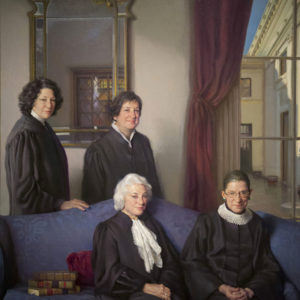Monday on Twitter — politicians’ preferred method of communication today — Sen. Rand Paul (R-KY) tweeted, after meeting with and reviewing the record of Supreme Court nominee Judge Brett Kavanaugh, “I have decided to support his nomination.”
Before this week, the senator remained “undecided” about the judge, raising concerns about his positions on privacy and the Fourth Amendment. As The Hill said, “Paul is a key vote” in Kavanaugh’s confirmation.
Republicans hold a slim majority of 51 in the senate but may only have 50 votes if Sen. John McCain (R-AZ), who is undergoing treatment for brain cancer, is unable to vote. Democrats number 47 in the chamber but two independent senators usually caucus with them, likely bringing their voting bloc to 49.
But Republicans cannot afford any defections among its ranks.
Just one Republican senator crossing party lines could result in a 49-50 vote against confirmation. An abstention could result in a tie. In the event of a tie, Vice President Mike Pence, as President of the Senate, would cast the deciding vote. If that were to happen, Pence would be the first vice president in U.S. history to cast a vote in the senate concerning the confirmation of a justice of the Supreme Court.
(Pence is no stranger to casting a tie-breaking vote of historic significance. That happened last year when the senate was deadlocked in confirming Betsy DeVos as the Secretary of Education. Samuel Morse, writing in The Baltimore Sun, noted that Pence’s decisive vote “represented the first time in the history of the senate that a vice president invoked his Article I authority to cast a tie-breaking vote in the confirmation of a member of the president’s cabinet.”)
No date has been set for hearings by the Senate Judiciary Committee or a vote by the full senate regarding the Kavanaugh consideration.
Meanwhile, Democrats are stirring and praying.
On Monday, Sen. Joe Manchin (D-WV) became the first Democrat to meet with Kavanaugh, as the nominee resumed making courtesy calls on Capitol Hill. USA Today reported that “the two met behind closed doors in Manchin’s Senate office for the longest of any of Kavanaugh’s 39 meetings with senators.”
Kavanaugh’s nomination injects even more adrenalin into the already hyper-political arm of the 2018 mid-term elections.
Manchin is facing enormous pressure, especially if the Kavanaugh vote were to be held before the mid-terms. He is among ten Democratic incumbent senators running for re-election in states won by President Trump in 2016. Two are deep red states, like Manchin’s West Virginia, and Heidi Heitkamp’s North Dakota. She is fighting for senatorial survival in a state Trump carried by 36 points.
It is expected that more Democratic Senators will meet with the judge in coming days. Still, Democrats are likewise loathing to see fellow members side with Republicans on the looming Kavanaugh vote.
Because of recent rule changes made in the senate, Democrats have virtually no procedural power to block Kavanaugh from the high court. Instead, they are relying on a potent public relations campaign outside the senate that seeks a delay in the vote of the nominee (presumably sometime after the mid-terms) until a thorough examination is made of his long paper trail. Such an examination is part of the extensive vetting process for federal judicial nominations.
Before Kavanaugh became a judge in the appellate circuit he worked in the George W. Bush White House for a number of years. Today, those opposing Kavanaugh believe that documents (potentially millions of pages of archived official presidential records) relating to his work in the Bush administration need to be reviewed before any votes are cast. Those documents, the thinking goes, may reveal tantalizing insights into Kavanaugh’s legal, judicial and constitutional philosophy — if not his role in writing and arguing policy.
The most surprising news came from Supreme Court Justice Ruth Bader Ginsburg.
Nominated by President Bill Clinton in June 1993 — and confirmed only 50 days later — Ginsburg is now the oldest justice on the court, at 85. Next to Justice Sonia Sotomayor, she is, by most accounts, the most consistently liberal jurist on the bench.
Conservatives were giddy with the prospect that Ginsburg, who has battled cancer twice, might step down from the high court before the 2020 presidential elections. Were she to do so, President Donald Trump would be the first president since Richard Nixon to nominate three people to the court in his first term. (Trump nominated Neil Gorsuch as his first Supreme Court appointment early last year.)
But Ginsburg has no such plans.
In an interview given last weekend Ginsburg said, “My senior colleague, Justice John Paul Stevens, he stepped down when he was 90, so think I have about at least five more years.”
For some, like Aaron Blake of The Washington Post, Ginsburg’s announcement smacks of “suspicious political timing.” But liberal supporters were cheering and praying for her. Some even took to Twitter saying they would donate their organs to keep the justice alive.
The fervor surrounding the Supreme Court in 2018 could not have been imagined by the Founding Fathers in Federalist No. 78.

